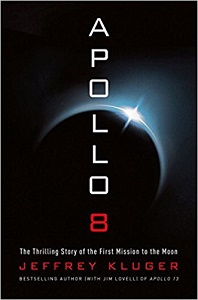 Apollo 8: The Thrilling Story of the First Mission to the Moon by Jeffrey Kluger
Apollo 8: The Thrilling Story of the First Mission to the Moon by Jeffrey Kluger
A lot of things didn’t go well in 1968. Senior Time Magazine writer Jeffrey Kluger (author of Lost Moon: The Perilous Voyage of Apollo 13) gives us the story of one of the things that did: NASA’s Apollo 8 mission in December of that year.
Astronaut Jim Lovell, commander of Apollo 13 and the focus of Kluger’s Lost Moon, is one of the crew of Apollo 8, but the person Kluger spends the most time with in this book is this mission’s commander, Frank Borman. When the Apollo program was struggling, especially after the Apollo 1 accident that claimed the lives of Gus Grissom, Edward White, and Roger Chaffee, Borman spent a lot of time on the Apollo capsule factory floor representing the astronauts. He was so good at the job that he nearly lost his place as an astronaut due to extreme competence.
As the Apollo program fell behind the schedule set with President Kennedy’s “before the decade is out” challenge, and with Russia making giant strides, a decision was made that changed everything – instead of executing the cautious plans currently in the schedule for Apollo 8, why not make a bold leap forward and make Apollo 8 a lunar orbital mission, thus accelerating the schedule? Kluger details the preparation over the following 16 weeks that led to the mission, which became the first manned mission to the Moon.
Without the successful Apollo 8 mission, containing and achieving the goals set for it by the launch date, Apollo 11 would not have been the Apollo that landed on the Moon. How that would have changed things is fodder for authors of alternate history.
Two remarkable things about the Apollo 8 mission:
First, it is where the famous “Earthrise” NASA photograph comes from. Borman, Lovell, and Anders were the first people ever to be far enough away from Earth to see it as a globe. All previous missions achieved orbit around Earth or less. In other words, all the astronauts to this point could look “down” and see the Earth beneath their feet at all times. Apollo 8 was the first mission for which that was not true.
…Now, however, Borman, Lovell, and Anders could see the planet floating alone, unsupported, in space. The Earth was no longer the soil beneath their feet or the horizon below their spacecraft. It was an almost complete disk of light suspended in front of them, a delicate Christmas tree ornament made of swirls of blue and white glass. It looked impossibly beautiful – and impossibly breakable.
What Borman said aloud was: “What a view!”
What Borman thought was: This must be what God sees.
Then he collected himself. “We see the Earth now, almost as a disk,” he radioed down.

Second, at one point on the way to the Moon, the Apollo 8 capsule stopped climbing uphill against Earth’s gravity and started falling toward the Moon due to the pull of the Moon’s gravity. Borman, Lovell, and Anders were the first people to be far enough away from Earth to experience that. The first people to be far enough away from the Earth for the Moon (or any other object) be the primary gravitational influence.
Both of those things are amazing to consider!
Jeffrey Kluger’s Apollo 8 is a crystal clear, well written account of this important event in the history of mankind’s exploration of space. It’s filled with details and he lingers just long enough to consider the implications of what was happening. It’s got a quick pace, it’s enjoyable, it’s moving.
According to a telegram Borman received after the Apollo 8 mission from a stranger: “Thank you, Apollo 8. You saved 1968.” The Moon was one thing, but saving 1968? That wasn’t a small feat, either.





